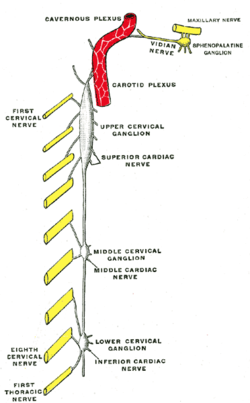The middle cervical ganglion is the smallest of the three cervical sympathetic ganglia (i.e. of the cervical portion of the sympathetic trunk).[1] It presumably represents the merging of the sympathetic ganglia of cervical segments C5–C6. It is usually situated at the level of the sixth cervical vertebra.
| Middle cervical ganglion | |
|---|---|
 Diagram of the cervical sympathetic. ("Middle cervical ganglion" labeled at center right.) | |
| Details | |
| From | Middle cardiac nerve |
| Innervates | Thyroid |
| Identifiers | |
| Latin | ganglion cervicale medium |
| TA98 | A14.3.01.016 |
| TA2 | 6609 |
| FMA | 6468 |
| Anatomical terms of neuroanatomy | |
Anatomy edit
The middle cervical ganglion is presumed to represent the union of the two sympathetic ganglia corresponding to cervical segments C5–C6 since its gray rami communicantes usually join the cervical spinal nerves C5–C6, however, the ganglion sometimes also contributes gray rami communicantes to spinal nerves C4 and C7.[1]
Relations edit
The ganglion is usually situated at the level of the sixth cervical vertebra,[1] lying medial to its carotid tubercle.[2] It is situated either[1] anterior[1][2] or superior to the inferior thyroid artery. It may adjoin the inferior cervical ganglion.[1]
Branches edit
- Gray rami communicantes – join the anterior rami[citation needed] of the cervical nerves C5–C6, sometimes also C4 and C7.[1]
- Thyroid branches – pass alongside the inferior thyroid artery to the thyroid gland.[1]
- Middle cardiac nerve – descends through the neck to reach the cardiac plexus in the thorax.[1]
Variation edit
It is sometimes absent,[1][2] having either fused with the superior cervical ganglion or become replaced by small ganglia within the sympathetic trunk.[1]
See also edit
References edit
- ^ a b c d e f g h i j k Standring, Susan (2020). Gray's Anatomy: The Anatomical Basis of Clinical Practice (42th ed.). New York. pp. 600–601. ISBN 978-0-7020-7707-4. OCLC 1201341621.
{{cite book}}: CS1 maint: location missing publisher (link) - ^ a b c Sinnatamby, Chummy S. (2011). Last's Anatomy (12th ed.). Elsevier Australia. p. 346. ISBN 978-0-7295-3752-0.
External links edit
- thoraxlesson4 at The Anatomy Lesson by Wesley Norman (Georgetown University) (thoraxautonomicner)
- Anatomy photo:31:07-0202 at the SUNY Downstate Medical Center – "The Sympathetic Trunk and Cervical Ganglia"
- Clinical Anatomy by Richard S. Snell seventh edition page 744